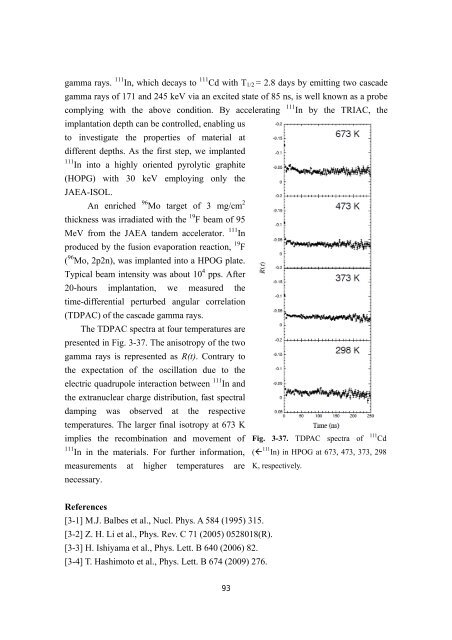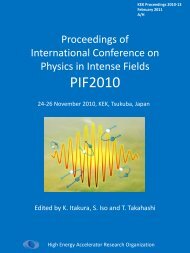TRIAC Progress Report - KEK
TRIAC Progress Report - KEK
TRIAC Progress Report - KEK
Create successful ePaper yourself
Turn your PDF publications into a flip-book with our unique Google optimized e-Paper software.
gamma rays. 111 In, which decays to 111 Cd with T1/2 = 2.8 days by emitting two cascade<br />
gamma rays of 171 and 245 keV via an excited state of 85 ns, is well known as a probe<br />
complying with the above condition. By accelerating 111 In by the <strong>TRIAC</strong>, the<br />
implantation depth can be controlled, enabling us<br />
to investigate the properties of material at<br />
different depths. As the first step, we implanted<br />
111<br />
In into a highly oriented pyrolytic graphite<br />
(HOPG) with 30 keV employing only the<br />
JAEA-ISOL.<br />
An enriched 96 Mo target of 3 mg/cm 2<br />
thickness was irradiated with the 19 F beam of 95<br />
MeV from the JAEA tandem accelerator. 111 In<br />
produced by the fusion evaporation reaction, 19 F<br />
( 96 Mo, 2p2n), was implanted into a HPOG plate.<br />
Typical beam intensity was about 10 4 pps. After<br />
20-hours implantation, we measured the<br />
time-differential perturbed angular correlation<br />
(TDPAC) of the cascade gamma rays.<br />
The TDPAC spectra at four temperatures are<br />
presented in Fig. 3-37. The anisotropy of the two<br />
gamma rays is represented as R(t). Contrary to<br />
the expectation of the oscillation due to the<br />
electric quadrupole interaction between 111 In and<br />
the extranuclear charge distribution, fast spectral<br />
damping was observed at the respective<br />
temperatures. The larger final isotropy at 673 K<br />
implies the recombination and movement of<br />
111<br />
In in the materials. For further information,<br />
measurements at higher temperatures are<br />
necessary.<br />
References<br />
[3-1] M.J. Balbes et al., Nucl. Phys. A 584 (1995) 315.<br />
[3-2] Z. H. Li et al., Phys. Rev. C 71 (2005) 0528018(R).<br />
[3-3] H. Ishiyama et al., Phys. Lett. B 640 (2006) 82.<br />
[3-4] T. Hashimoto et al., Phys. Lett. B 674 (2009) 276.<br />
93<br />
Fig. 3-37. TDPAC spectra of 111 Cd<br />
( 111 In) in HPOG at 673, 473, 373, 298<br />
K, respectively.













